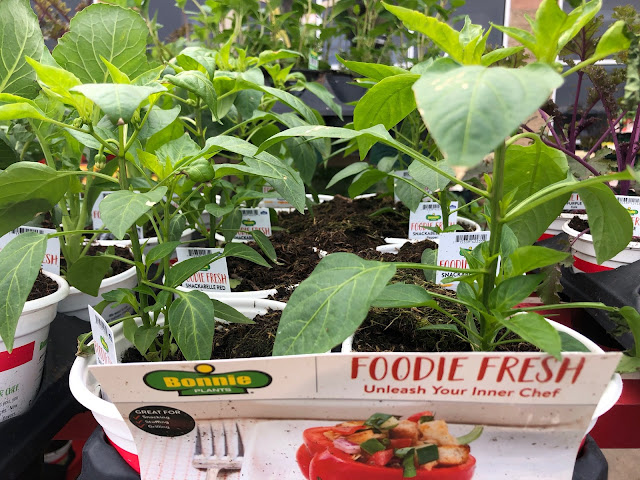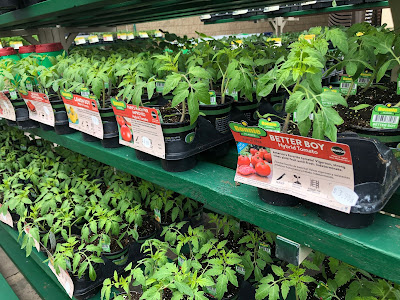
Vegetables do their best in the right conditions

|
|
Oh, these poor pepper plants, at a big-box store on Feb. 9. Note the flower buds already
on some of them. (Photos: Kathy Morrison)
|
There they were Tuesday, flats and flats of them, on shelves that were empty less than a week before: Snackabelle Red pepper plants. Most of them were 5 to 6 inches tall, and several already had flower buds.
Really? And February not even half over yet?
Across the aisle were many dozen tomato plants, apparently just off the truck, all the perfect size for transplanting. If only it were April. Or even late March.
It made my heart break to see them all.
These plants, even if they are purchased soon, are going to have rough, rough lives. When they go into the ground, their little roots are going to be so cold. The soil in my raised bed today is 52 degrees; the ground itself is even colder, 51. The roots are where the action is when a seedling is transplanted. They anchor the plant against wind and weather, and send nutrients and water up to the leaves, where the plant's food is made via photosynthesis.
Oh, yeah, there's not much sunlight out there right now, either. And we still have lows in the 30s in the forecast.
Now, if an experienced gardener really, really wanted to buy one of those Snackabelles right this second , he or she could bring it home, pot it up immediately, and put the container in the warmest outdoor spot in the garden, preferably under the eaves next to the house. Maybe even move the pot into the house. And then baby it until mid-spring, when UCCE Sacramento County master gardeners recommend planting out peppers. (See their great vegetable planting chart -- for both seeds and plants.)
But you know that's not going to happen because:
a) many experienced gardeners like to grow their peppers from seed, having started them in the past few weeks, or
b) they know they can buy fresh transplants at local nurseries in April, and/or
c) they have better things to do with their gardening time than babying a potted bell pepper through unpredictable weather.
So it will be inexperienced gardeners or impulse buyers who take home a few of those pepper plants. Then the plants -- newly moved from their cozy greenhouses to outdoors at a big-box store and then to someone's garden -- will just sit there for a long time, assuming we don't get any more frost. The stressed plants won't grow much, might drop their leaves and might be chomped by slugs or birds. The flower buds will fall off, too, unpollinated. Finally the owner will pull the plant out and go buy something else.

|
|
Some good tomato varieties here, but it's at least 6 weeks too
early to plant them in the Sacramento area. And 11 weeks until
our unofficial "tomato planting day," April 28. |
Moral of story: Just because a plant is offered for sale doesn't mean it's the right season or right climate to plant it. A little homework on planting will save any gardener a bucket of money.
Comments
0 comments have been posted.Sacramento Digs Gardening to your inbox.
Sites We Like
Garden Checklist for week of July 21
Your garden needs you!
* Keep your vegetable garden watered, mulched and weeded. Water before 8 a.m. to reduce the chance of fungal infection and to conserve moisture.
* Feed vegetable plants bone meal, rock phosphate or other fertilizers high in phosphate to stimulate more blooms and fruiting. (But wait until daily high temperatures drop out of the 100s.)
* Don’t let tomatoes wilt or dry out completely. Give tomatoes a deep watering two to three times a week.
* Harvest vegetables promptly to encourage plants to produce more. Squash especially tends to grow rapidly in hot weather. Keep an eye on zucchini.
* Pinch back chrysanthemums for bushy plants and more flowers in September.
* Remove spent flowers from roses, daylilies and other bloomers as they finish flowering.
* Pinch off blooms from basil so the plant will grow more leaves.
* Cut back lavender after flowering to promote a second bloom.
* It's not too late to add a splash of color. Plant petunias, snapdragons, zinnias and marigolds.
* From seed, plant corn, pumpkins, radishes, winter squash and sunflowers.